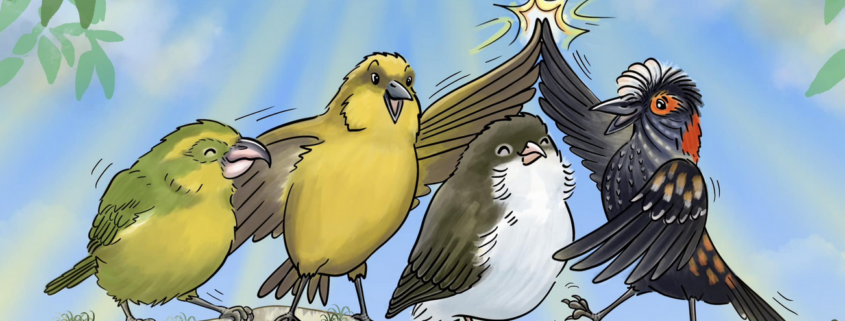Wildlife conservation agencies (state and federal) are one step closer to protecting forest birds from mosquito-borne diseases in Kauaʻi
HONOLULU — The Hawaiʻi Department of Land and Natural Resources (DLNR) and U.S. Fish and Wildlife Service (USFWS) are one step closer to protecting forest birds from mosquito-borne diseases in key high-elevation native forest bird habitat on Kauaʻi, with their proposal to employ Incompatible Insect Technique (IIT) to reduce mosquito populations. A jointly prepared Environmental Assessment (EA) has been finalized and issuance of a finding of no significant impact (FONSI) at the state and federal levels.
Introduced diseases, particularly avian malaria spread by invasive mosquitoes, are the greatest threat to forest birds. Just one bite can kill a forest bird. Implementing mosquito control is urgently needed to prevent extinction of Hawai‘i’s forest birds and is part of the U.S. Department of the Interior’s Hawaiian Forest Bird Keystone Initiativeand supported with Bipartisan Infrastructure Law funding. The DOI offices and bureaus, working alongside the DLNR, the Native Hawaiian community, and many public and private partners are leading a comprehensive initiative to prevent extinction of additional Hawaiian forest birds. The use of IIT mosquito control is a critical component of a multi-pronged initiative and the DOI Strategy for Preventing the Extinction of Hawaiian Forest Birds.
IIT is a way to control insect pests, like mosquitoes, without using harmful chemicals. In Hawaiʻi, this technique involves releasing male mosquitoes that carry a different, incompatible strain of bacteria (Wolbachia) than what is present in the wild mosquito population. When these incompatible male mosquitoes mate with the wild female mosquitoes, the resulting eggs do not hatch, decreasing the mosquito population over time. This approach does not employ genetic engineering and does not involve or result in the genetic modification of either mosquitoes or bacteria.
“Already, 10 of the 16 native honeycreepers of Kaua‘i have gone extinct, and three of the remaining six species are endangered or threatened, with research documenting that the ʻakeke‘e and ʻakikiki would be driven to extinction within the next decade unless immediate action is taken.”, said Earl Campbell, U.S. Fish and Wildlife Service field supervisor for the Pacific Islands Fish and Wildlife Office; “The Service’s purpose and need for the project is an urgent matter and directly supports DOI’s strategy that contributes to the recovery and conservation of several federally listed species, including the ‘akeke’e, ‘akikiki, puaiohi, and ‘i’iwi, as well as other avian species with concerning declines in population and range.”
The Service and DLNR jointly produced the draft EA, released on June 23, 2023, for a 31-day commenting period that concluded on July 24, 2023. On July 11, 2023, the Service, DLNR, and their partners, held an open house on Kauaʻi to dialogue with members of the community, receive public comments, and answer questions.
On September 22, 2023, the Service issued a FONSI to conclude the National Environmental Policy Act process and document the decision of the final EA. A FONSI is issued when environmental analysis and interagency review during the EA process find a project to have no significant impacts on the quality of the environment. The statements and conclusions reached in the FONSI are based on documentation and analysis provided in the final EA.
The DLNR, a cooperating agency on this project, has prepared its own finding covering actions on state-managed lands and private lands within the project area. Today, the Hawai‘i Board of Land and Natural Resources approved and issued a State FONSI, which concludes the Hawai‘i Environmental Policy Act process and enables DLNR to move forward with IIT mosquito control on State lands.
“Native honeycreepers like the ‘akikiki have literally crashed in their native habitats in the montane regions of Kaua‘i. The latest surveys conducted by the Kaua‘i Forest Bird Recovery Project, only detected five remaining ‘akikiki in the wild,” said DLNR Division of Forestry and Wildlife Administrator David Smith.
Hawaiʻi’s native forest bird species have undergone precipitous declines and extinctions since the arrival of humans to the archipelago, particularly Europeans; 39 of the 56 native Hawaiian honeycreepers have gone extinct and 11 of the remaining 17 species are endangered or threatened. Although several factors have led to declines of these remaining species, the main threat to Hawaiian honeycreepers is currently avian malaria (Plasmodium relictum) and avian pox (Avipoxvirus spp.); nonnative diseases that are principally spread by the nonnative southern house mosquito (Culex quinquefasciatus). Until recently, there were no viable means available to control mosquito vectors at the landscape scale within natural areas in Hawaiʻi.
The DLNR manages 22 natural areas comprising the most intact habitats on Kauaʻi with the intent of safeguarding these habitats and species, as well as the cultural heritage associated with them. The proposed project would occur on approximately 59,204 acres (23,959 hectares) of forest reserves, state parks, and private lands in the Kōkeʻe and Alakaʻi Wilderness areas of Kauaʻi. This project is consistent with the statutory missions and responsibilities of the Service and DLNR.
To find the Final EA, the FONSI, Q&As and more information on IIT mosquito suppression in Kauaʻi, visit:
https://www.fws.gov/project/saving-kauai-forest-birds
The U.S. Fish and Wildlife Service works with others to conserve, protect, and enhance fish, wildlife, plants, and their habitats for the continuing benefit of the American people. For more information, visit www.fws.gov/pacificislands, or connect with us through any of these social media channels at https://www.facebook.com/PacificIslandsFWS, www.flickr.com/photos/usfwspacific/, https://medium.com/usfwspacificislands or www.twitter.com/USFWSPacific.
Artwork by Joanna Maney



